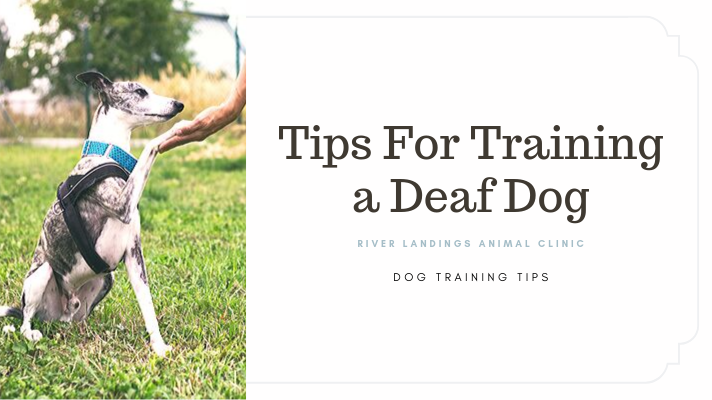Even though they aren't able to hear commands, deaf dogs can be trained to obey their owners and commands. The process comes with its own set of challenges, requiring a bit of extra patience, but isn't outside the capability of most dog owners.
Some dogs are more prone to deafness than others: Dalmatians, Whippets, English Setters, and Jack Russell Terriers seem to have the highest instances of congenital deafness. But as dogs age, just like people, their sense of hearing often worsens over time.
For puppies who don't (yet) have hearing problems, consider incorporating hand gestures with voice commands when you train them. That way, if your dog loses its hearing as it ages, it is already familiar with the signs for the various commands.
Getting the Attention of a Deaf Dog
Before you can ask a dog to do anything, you must first have its attention.
There are a few things you can do to get a deaf dog to look at you, such as stamping your foot on the floor. Sometimes the vibrations coming through the floor are enough to turn your dog's attention in your direction.
Use a Flashlight
Some owners of deaf dogs use a flashlight to signal to their dog. You can train a dog to look at you by turning a flashlight on and off. Continue to do so until your dog turns to see where the light is coming from. As soon as the dog looks at you, reward it with a treat. The dog will soon learn that a flash of light means that it needs to look at you.
Use a Vibrating Collar
These electronic collars are different from those that give shocks to aid in training (which you want to avoid because they provide negative reinforcement to the dog). These simply vibrate when you press a button on a remote.
You can train a dog to look at you by pressing the button to make the collar vibrate, and continue doing so until your dog looks at you. As soon as the dog turns its attention to you, stop the vibrations and offer a treat.
Try Hand Signals
Many people train dogs by using hand signals for basic obedience commands. There is a standard hand signal most dog trainers use to teach each command, but you can also create your own hand signals.
Instead of giving a solely spoken command, you start off by making sure your dog's attention is on you, and then give the hand signal. You then train the dog to perform the command just as you would any other dog.
Use Sign Language
Most people communicate with their dogs for more than the basic commands, learning from the repeated connection between the words and the actions. You can communicate in a similar way with a deaf dog, but rather than using spoken words, you can use sign language.
Many owners of deaf dogs find it useful to learn a few simple words in American Sign Language and use them when doing everyday tasks with their dogs. You can also create your own signs for different words. As long as you and your dog know what the sign means, you should be able to communicate easily.
Reward Good Behavior
While many dogs find it rewarding to get verbal praise from their owners, this won’t be ideal for deaf dogs. Keep some small treats on hand to give your deaf dog positive reinforcement when it obeys a command correctly.
Once your dog has a good understanding of each command, you can use treats less frequently. Be sure in the early days of training when you're using a lot of treats that you cut back on your dog's meals accordingly.
Common Problems and Avoiding Them
Initially, deaf dogs may be startled by a person unexpectedly touching them to gain their attention, especially if they are touched while sleeping. Startling a dog can lead to it snarling or snapping out of fear, much in the same way a person might yell out if someone sneaks up and startles them.
Practice touching your dog very gently on its shoulder and back. Give it treats immediately following the touch. Try to do this often throughout the day, and soon your dog will learn that having someone touch them from behind means good things are about to happen.
A common mistake many new owners of deaf dogs make is not talking while they give their non-verbal commands. Just because the dog can't hear you doesn't mean you should remain silent; often your body language can appear unnatural if you give a command silently.
To ensure the visual commands come naturally to you and translate easily to your dog, go ahead and speak the words of a command as you perform the action.
Meet our featured deaf dog, Tater
The sweetest face!
Tater loves his owner, Amanda (who also is our office manager and technician).
Hear From Us Again
Don't forget to subscribe to our email newsletter for more recipes, articles, and clinic updates delivered to your inbox (here). Or, you can keep up to date by liking and following our Facebook page (here).
Related: We have more information under our dog health + client care tags.



